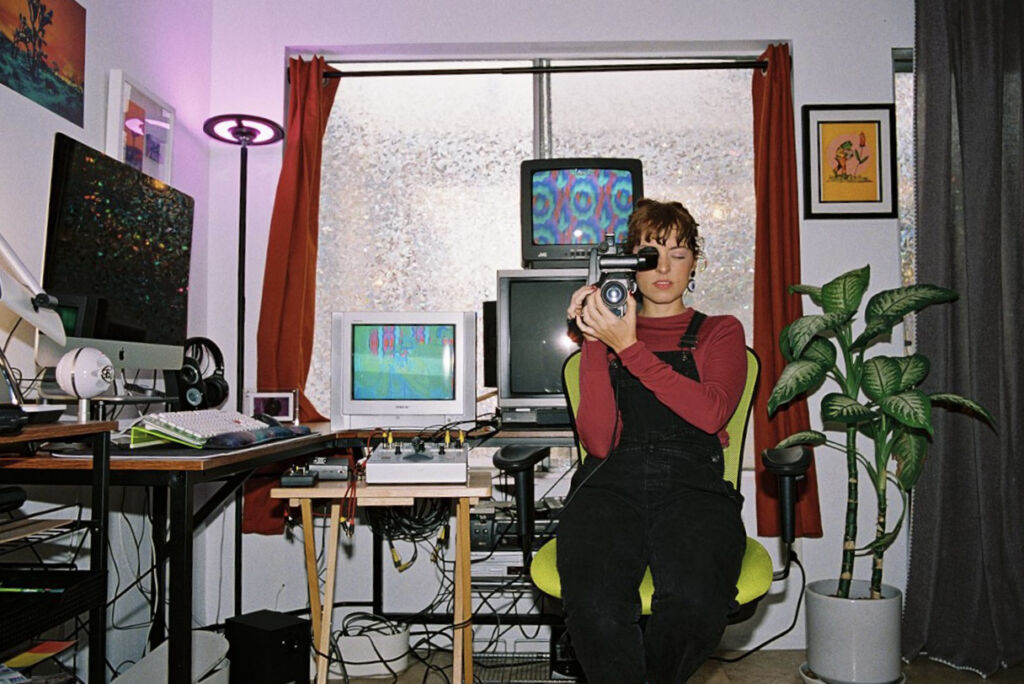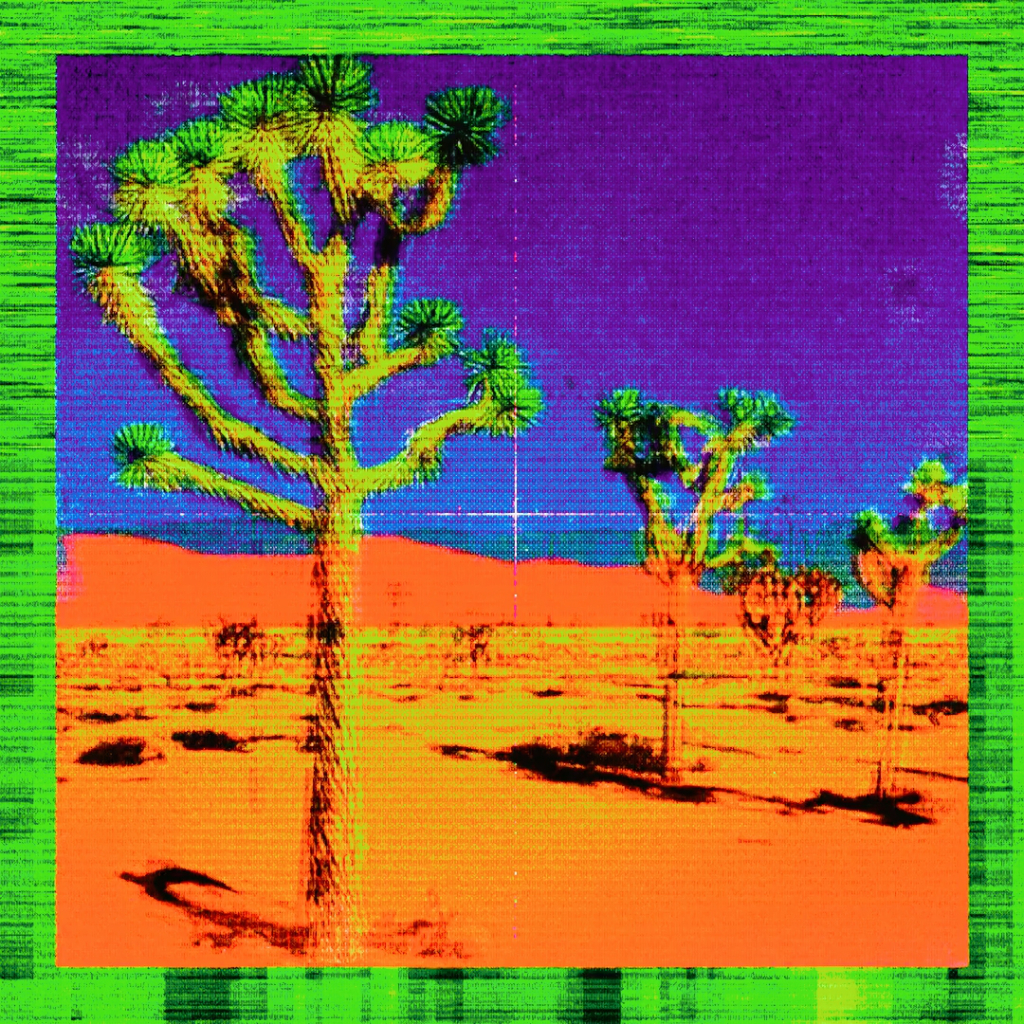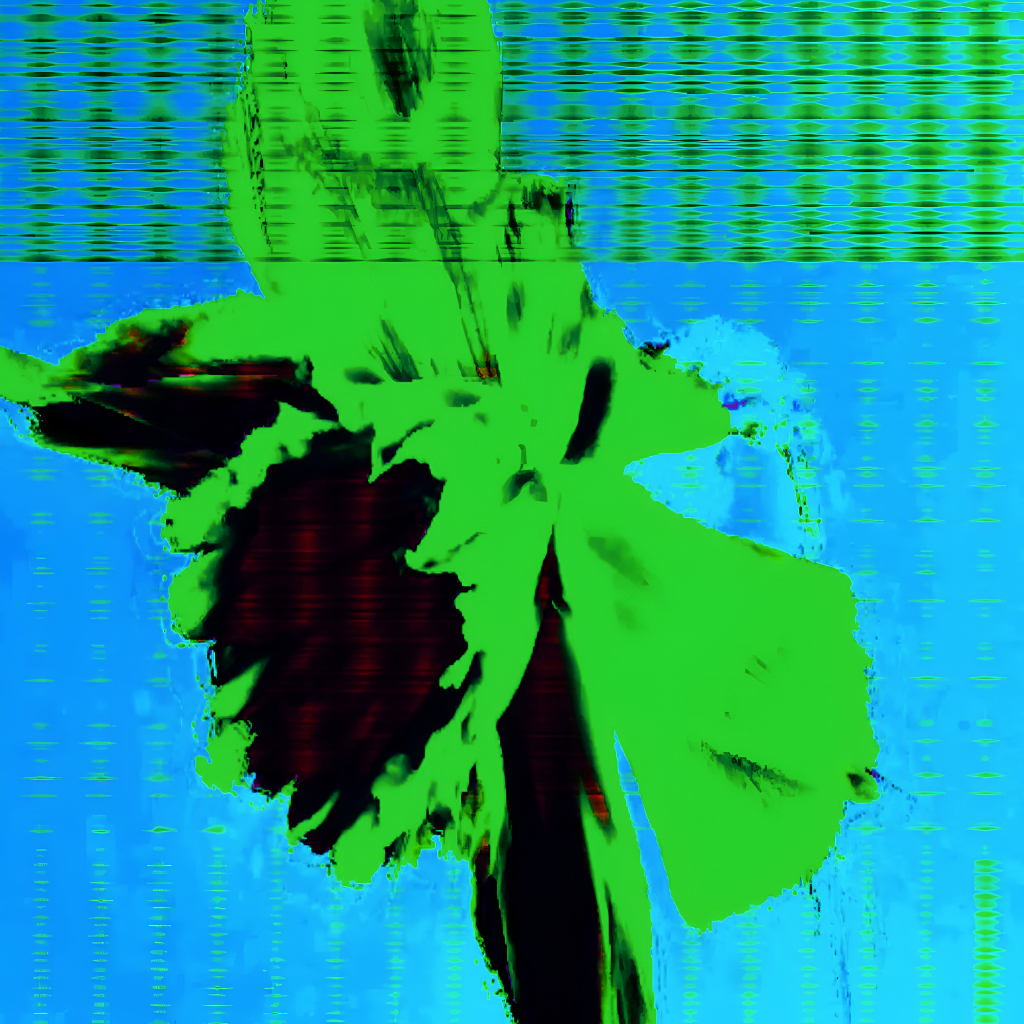Interview by Carlota Gamboa

Reimaging what it means to experience an imagistic landscape, transmedia artist Ellie Pritts gives viewers a vantage point into the colourful universe of their rendering. Originally from Chicago, the Los Angeles-based creator melds techniques from various artistic practices to breathe new light into the relationship between artificial intelligence and obsolete technologies.
As an artist with synesthesia, Pritts engages deeply with the captured moment to translate textures and optic layers with what they call “the visual language and culture of the fin-de-siècle.” By combining vintage and new-age technologies, like circuit-bent hardware and AI, Pritts opens visual dimensions that create unique perspectives of the world, particularly in relation to nostalgia. Their pieces ask a viewer to go beyond the surface and more closely perceive the intricate complexities of a world around them.
Included in TIME Magazine as a photographer to look out for, their psychoactive neon aesthetic has had them producing work for brands such as Apple, Levi’s and Onitsuka Tiger. Pritts was also featured in this year’s Microsoft holiday design campaign, in which she created artworks using AI with Microsoft Designer to visualise seven different people’s seasonal stories.
In Static Glitch Fleur, a series of prints that take stills from an analog video stream transposed onto real footage of flora, Pritts takes simultaneity to an alternate reality. The pieces behave as a “technicolour effigy of the artist’s own dreamscape,” where the pre-formed process provides the viewer with a sensation of being within the computer itself. Selections from this series are featured in the exhibition Interreality in Los Angeles, curated by Mieke Marple and produced by Steven Sacks of bitforms gallery and Aubrie Wienholt of Wienholt Gallery.
Pritts’s most recent series, Arid Articulations, uses a similar method to arrive at the distinctly pictured nature. The process calls for outdated technology to create the hue, cadence and pattern before AI disrupts the familiar imagery. Though their work has long been associated with California’s Joshua Tree National Park, Arid Articulations explores the existing magic found in the Mojave Desert. The fractal-like video art was exhibited in Medias Res and is available for purchase through OpenSea.
Pritts is also an artist who lives with the degenerative neurological condition Charcot-Marie-Tooth disease (CMT) and has been open about the physical impact it has on their creative process. Due to its effect on the peripheral nerves (hands and feet), Pritts must alter their way of making, but despite the physical modifications CMT may cause, the boundaries have not closed for the artist, as Pritts finds themselves adapting to new methods of being. These methods are imbued directly within the work and Pritts’s preoccupation with creating work that makes the viewer feel ‘limitlessness.’ As such, Pritts has become a leading voice in the positive role AI can have in one’s life.






The notion of bridging a digital universe with an analog one is very present in your work. When did you first fall in love with the digital landscape? Was there an ‘aha’ moment?
Actually, yes, there was a bit of an ‘aha ’moment for me a little over ten years ago. I have a background in film photography but had (hesitantly) made the transition to digital a few years prior. I needed to make a website for myself because I couldn’t afford to hire someone to do it for me, so I started learning to code. This led me to my first digital art project, Project L0SS, which was made using a code-based image glitching tool.
As a former concert cellist, does your experience as a classically trained musician inform your work and sensibility?
My relationship with music runs deep; it’s how I first learned to emotionally express myself. Having those formative experiences and learning how to feel simultaneously, I was learning how to play music, which significantly shaped how I see the world and myself. I consider it a huge gift, one that took me many years to fully appreciate.
You currently have work featured in the group exhibition Interreality. Can you tell us more about the Static Glitch Fleur prints that appear in the show and how you got involved?
The Static Glitch Fleur series are prints made from still frames of video art that I created. When bitforms gallery founder Steven Sacks curated my solo exhibition, In The Screen I Am Everything, he had the idea of dedicating a section of the exhibition space to the Glitch Fleurs. This inspired me to explore different mediums for the pieces in addition to the original video artwork. I created a mural and printed two still frames from other glitch flower videos I had created. The video and both prints from that exhibition sold fairly quickly, which made me happy. I was thrilled when Mieke wanted to include new prints from the series for Interreality.
What are your biggest influences or inspirations when creating work like Static Glitch Fleur?
I was inspired by my curiosity and by new technology. The series began without me realising it would be a series. I was experimenting with a new video synthesiser and got lost in it. I loved how the flowers’ natural beauty played with the synthesiser’s stark digital textures. Printing the frames made me fall in love with those textures even more.
What other projects are you working on or looking forward to?
I’ve been invited to do a solo exhibition in Europe next spring, which will be a ton of fun. My Arid Articulations series is going to be on exhibit at a museum next year, and I’m very excited about that as well. I’m looking forward to announcing more about all of this soon!
Could you talk to us about the past, present, and future of Shadow Kitchen? I coincidentally attended the glitched screening of Stephen Speilberg’s AI because my brother had a feature in it as well, and I couldn’t help but think that these kinds of ‘hacked’ or ‘cursed’ renditions of popular media deserve a space to be viewed in a larger community context.
I love that; what a small world! I’m completely biased in agreeing that hacked media deserves such spaces. In 2020, I co-founded a video art collective called Racer Trash, which revolved around re-interpreted film and television. Racer Trash kind of took the internet by storm during quarantine, which forged many wonderful connections with fellow creatives and collectives like Shadow Kitchen.
The Artcfiitaiiiiale Iintillilliignice project was a collaboration between Dream Video Division and Shadow Kitchen, whom I hadn’t had the pleasure of working with before. DVD is a collective formed by several former Racer Trash members, so that was my connection to the project. The piece Ariel Gardner and I created for it was a ton of fun to work on, and I love how it turned out.
You often include obsolete technology into your work, even when you’re using artificial intelligence. Does this combination generate any interesting surprises?
Yes, constantly. It’s my absolute favourite thing about working with these tools and mediums. I’d say at least 50% of my creative output between AI and old hardware comes as a total surprise to me. It motivates me to create daily; I just want to see what happens.
As a non-binary artist, do you feel like you come up against resistance in male-dominated tech and film spaces? How do you move past that?
Most of the resistance I have met thus far has been in getting exposure and sales relative to my male peers, but that feels so far from the creative act itself that I don’t think about it too much. It’s very indirect, so it’s easy for me to tune it out. But every once in a while, it can get me down and be super demoralising. I know women and NB folks in this space have male alts. I’ve been advised to do the same, but I feel like I hardly have enough time to manage my persona on the internet. I want to spend less time online, so I usually look for any reason to unplug. This helps me move past the noise most of the time.
What messages or subjects do you want to express through your art?
My biggest hope is to convey the message that anything is possible. I want to incite curiosity and introspection. I want to inspire people to think and create without limits.
What’s your chief enemy of creativity?
Plans of any sort. Even if the plan is to ‘be creative’. In a perfect world, I have no appointments or errands, no meetings, just an abundance of free time and an uncluttered mind.
You couldn’t leave without…
At least 32 ounces of water.





